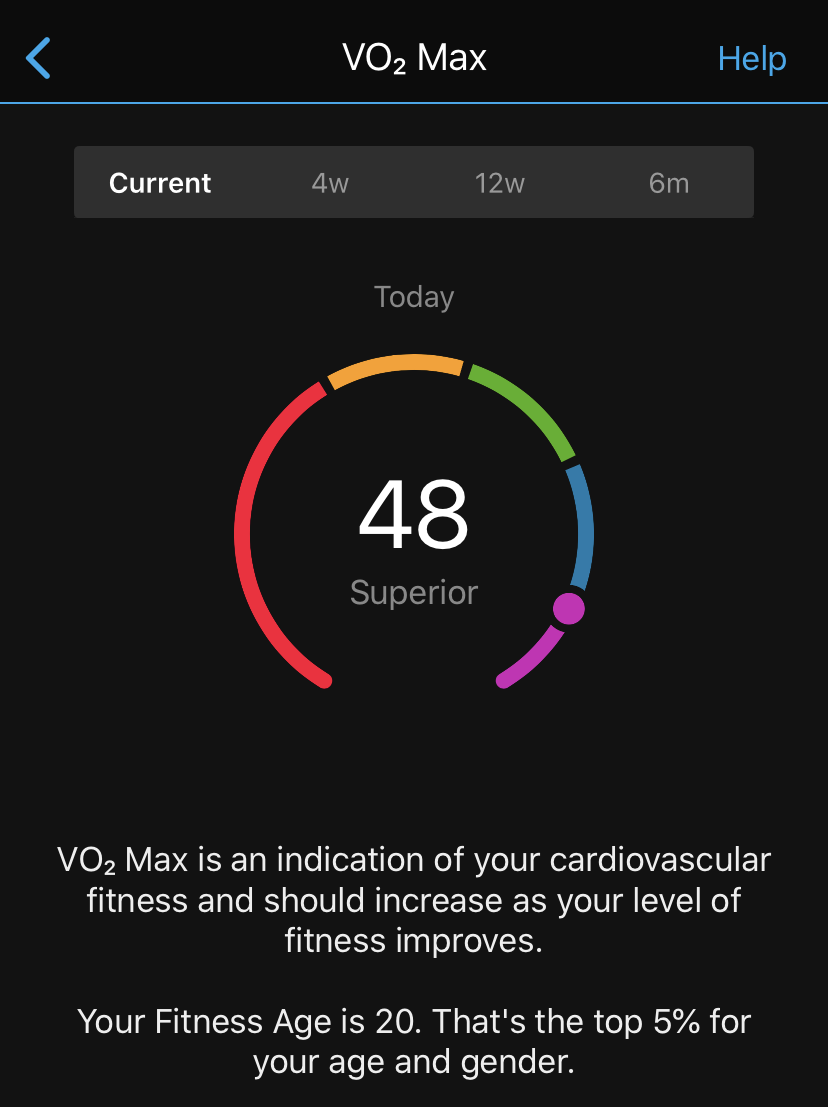Have you heard about VO2 Max? I probably saw it here and there, but I never gave it a second thought until I got a new Garmin watch which measures it and displays it.

Definition
According to Wikipedia, VO2 Max is ‘the maximum rate of oxygen consumption measured during incremental exercise; that is, exercise of increasing intensity’. Basically, it describes what shape your cardiovascular system is in. It’s important for both endurance athletes, telling them how their training is progressing, and ‘normal’ people, for whom there is a relationship between cardiovascular disease and mortality rates from variety of causes increases as this indicator drops. Here are charts of ranges:
Women:

Men:

The name VO2 Max comes for Volume of O2 (oxygen) Maximum. It doesn’t really roll off the tongue, does it… It’s usually measured as liters of oxygen per minute or milliliters of oxygen per kilogram of body mass. Something to note: this indicator is not directly correlated with body mass or species of animal.
How to figure out your VO2 Max?
Well, most people do it through their smart watches, such as my Garmin. It’s an estimate based on your pace and heart rate while you’re running. It’s not highly precise, but it will help you see where you place and you can see progress as you train.
In general, smart watches overestimate your numbers some. Difference is larger if you use a measurement from your wrist, as opposed to a chest strap. But yes, dear reader, there is a way to get a perfectly accurate measurement! How? If you have an access to proper type of a lab (most of us probably don’t), you can get it done. It involves a mask with a sensor, measuring oxygen you breath in, what you breath out and your heart rate. Oh, and let’s not forget about either a bike or a treadmill, where you keep increasing level of difficulty. From what I’ve been told, it’s not really a pleasant experience.
How much does it Max matter?
VO2 Max isn’t an equally useful metric to all. These days, science can provide you with dozens of numbers about your training and where are you at at any given moment. If you’re a nerd who enjoys all of this, then you may like knowing what your VO2 Max is. From my perspective, the most appealing aspect of it is knowing if I’m progressing. If you happen to know what’s your speed at VO2 Max, then there may be a more practical application: knowing what your pace should be during intervals training.
How to change your VO2 Max?
If you want it to drop, just spend a couple of weeks on the couch 😉.
Oh, wait, that’s not what you meant, is it? Right, you want to improve it. Commendable, as it is how you improve your fitness. The answer is rather banal: it’s the same as with every other metric you want to improve in endurance training. Main ones are:
- High intensity training – this way you train your heart to pump out more oxygenated blood
- Intervals training – if you thought this wouldn’t show up, you were lying to yourself…
- Alternating days of intervals/ high intensity with steady pace over longer distance
- Keep pushing yourself – to be fair, it’s the only way to grow in life, isn’t it? If you’re always doing the exact same thing, how are your results going to change?
I hope this helps! I know I’ve been wondering about VO2 Max and tried to figure out how to incorporate it into my training. Apparently, I have been doing it right: using it to monitor my progress.
Take care and as always, I will see you on the road!
